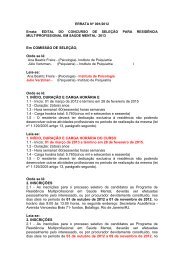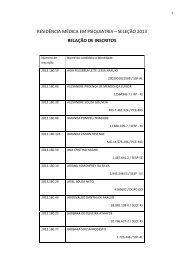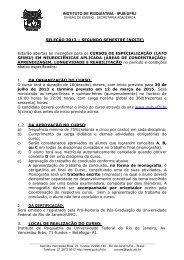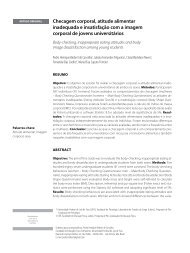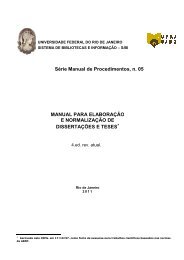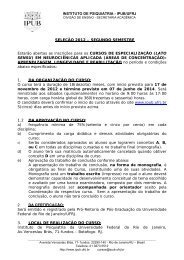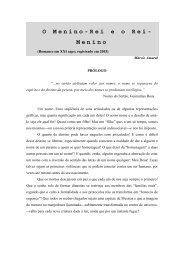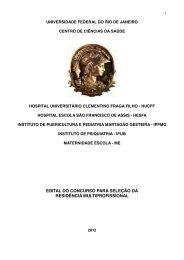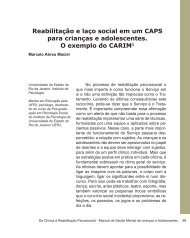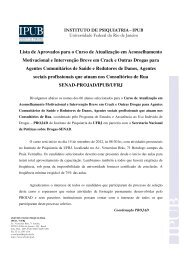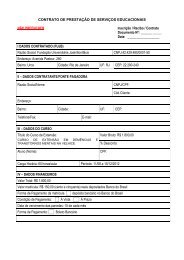Originais â Originals outubro | dezembro ⢠2011 - IPUB - UFRJ
Originais â Originals outubro | dezembro ⢠2011 - IPUB - UFRJ
Originais â Originals outubro | dezembro ⢠2011 - IPUB - UFRJ
Create successful ePaper yourself
Turn your PDF publications into a flip-book with our unique Google optimized e-Paper software.
244 Benko CR et al.<br />
ORIGINAL ARTICLE<br />
Analyses of the NBI with respect to CBCL<br />
psychopathological indicators<br />
The averages obtained in the analyses of the subscales of<br />
the CBCL were compared between the groups, according<br />
to their NBI scores (NBI < 30 and NBI ≥ 30) to verify the<br />
statistical difference for each subscale. Figure 1 summarizes<br />
the results obtained for the two groups, participants with an<br />
NBI < 30 versus those with an NBI ≥ 30 points. These analyses<br />
indicate that significant correlations were detected by the<br />
CBCL for the problems of: anxiety and depression (p = 0.041);<br />
social difficulties (p = 0.028); attention problems (p = 0.001);<br />
aggressive behavior (p = 0.015); ADHD (p < 0.001); and<br />
conduct problems (p = 0.032); as well as for the externalizing<br />
problems (p = 0.03); and total problems (p = 0.017).<br />
T-SCORE<br />
71<br />
68<br />
65<br />
62<br />
59<br />
56<br />
AD<br />
DW<br />
SC<br />
SP<br />
NBI: “Nutritional Behavior Inventory”; CBCL: “Child Behavior Checklist”; AD: anxiety/depression; DW: depression/<br />
withdrawal; SC: somatic complaints; SP: social problems; TP: thought problems; AP: attention problems; RRB:<br />
rule-breaking behaviors; AB: aggressive behaviors; AfP: affective problems; AnP: anxiety problems; SP: somatic<br />
problems; ADHP: attention deficit/hyperactivity problems; ODP: oppositional defiance problems; CP: conduct<br />
problems; IP: internalizing problems; EP: externalizing problems; TP: total problems. * (p < 0.05).<br />
Figure 1. Graph comparing the NBI scores and the average T<br />
scores of the CBCL.<br />
Discussion<br />
CBCL – Psychopathologies<br />
TP<br />
AP<br />
RBB<br />
AB<br />
AfP<br />
AnP<br />
NBI < 30<br />
NBI ≥ 30<br />
SP<br />
ADHP<br />
ODP<br />
CP<br />
IP<br />
EP<br />
TP<br />
The present results indicate that the Portuguese version of<br />
the NBI is a reliable instrument. Furthermore, a comparison of<br />
the NBI results with data obtained with the CBCL – a widely<br />
used instrument with excellent psychometric properties<br />
and convergence between structured interview-derived<br />
diagnoses – demonstrated that the NBI can also be useful<br />
for assessing psychopathological symptoms related to the<br />
eating habits and behavior of children and adolescents.<br />
Participants with high NBI scores also presented indicators<br />
of mood, attentional, and behavioral problems in the CBCL.<br />
There is a general consensus that the incidence rate of<br />
psychiatric disorders in children and adolescents has risen over<br />
the last few decades. Although the reasons for this increase<br />
remain speculative, some important research has focused<br />
on possible causes and preventions for these disorders. The<br />
first aim of the present work was to translate and validate the<br />
NBI for Portuguese language speakers, and the second aim<br />
was to analyze whether factors such as eating behaviors and<br />
habits could be associated with psychopathology during<br />
late childhood and early adolescence. The goal was to find<br />
simple ways to identify symptoms and factors that negatively<br />
contribute to the mental health of this population or cause<br />
it to deteriorate. The NBI is a paper and pencil questionnaire<br />
that provides a straightforward analyzable inventory that can<br />
be applied in triage clinical settings or even at schools.<br />
Cultural adaptations and adaptations in relation<br />
to the sample<br />
After the translation and back-translation of the original NBI,<br />
some questions needed to be withdrawn or adapted in light<br />
of the equivalence of construction comparison. Specifically,<br />
questions about smoking (an open question) and alcohol use<br />
(question 31) were removed from the study. We observed<br />
discomfort and resistance to these questions during the pilot<br />
application of the first questionnaire related to the age range<br />
(9-12 years) of the study’s participants. The questions were<br />
removed in order to facilitate the participants’ adherence.<br />
The cultural adaptations proposed did not imply changes<br />
to the main content of the questions; we confirmed this by<br />
observing comparisons between the back-translation and<br />
the original instrument, so as to identify the equivalence<br />
of construction. However, for those wishing to investigate<br />
issues related to alcohol and tobacco use in adults, the<br />
omitted questions may be left in the NBI.<br />
The NBI was analyzed for internal consistency using<br />
Cronbach’s alpha index 27 , which assesses the reliability of<br />
a test in situations in which the researcher is not able to<br />
do other interviews with the individual, but which require<br />
an appropriate estimate of the average degree of error. In<br />
general, scales with an alpha value lower than 0.70 should be<br />
avoided. The alpha value for our translated, adapted NBI was<br />
0.8896, and there were no questions outside the expected<br />
average, indicating that the instrument had good internal<br />
consistency, in accordance with what we expected for its<br />
validation.<br />
Clinical implications and study limitations<br />
The present study had some limitations. First, our sample<br />
was made up mainly of male participants. This gender<br />
imbalance was related to the characteristics of our center’s<br />
line of research, as the students were referred to us from<br />
local schools 21,22 . In this population, teachers tend to<br />
recommend or refer students with externalizing symptoms,<br />
rather than those with internalizing symptoms, and research<br />
has shown 30 that boys tend to have more externalizing<br />
problems than girls. Second, since the NBI has not been<br />
translated to other languages (e.g., Spanish), we were unable<br />
J Bras Psiquiatr. <strong>2011</strong>;60(4):240-6.




